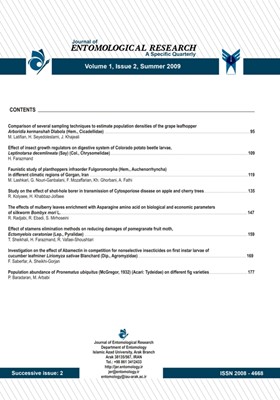-
-
List of Articles
-
Open Access Article
1 - Comparison of several sampling techniques to estimate population densities of the grape leafhopper Arboridia kermanshah Dlabola (Hem., Cicadellidae)
M. Latifian H. Seyedoleslami J. Khajeali -
Open Access Article
2 - Effect of insect growth regulators on digestive system of Colorado potato beetle larvae, Leptinotarsa decemlineata (Say) (Col., Chrysomelidae)
H. Farazmand -
Open Access Article
3 - Faunistic study of planthoppers infraorder Fulgoromorpha (Hem., Auchenorrhyncha) in different climatic regions of Gorgan, Iran
M. Lashkari G. Nouri Ganbalani F. Mozaffarian Kh. Ghorbani A. Fathi -
Open Access Article
4 - Study on the effect of shot-hole borer in transmission of Cytosporiose disease on apple and cherry trees
R. Kolyaee H. Khabbaz Jolfaee -
Open Access Article
5 - The effects of mulberry leaves enrichment with Asparagine amino acid on biological and economic parameters of silkworm Bombyx mori L.
R. Radjabi R. Ebadi S. Z. Mirhoseini -
Open Access Article
6 - Effect of stamens elimination methods on reducing damages of pomegranate fruit moth, Ectomyelois ceratoniae (Lep., Pyralidae)
T. Sheikhali H. Farazmand R. Vafaei-Shoushtari -
Open Access Article
7 - Investigation on the effect of Abamectin in competition for nonselective insecticides on first instar larvae of cucumber leafminer Liriomyza sativae Blanchard (Dip., Agromyzidae)
F. Saberfar A. Sheikhi-Gorjan -
Open Access Article
8 - Population abundance of Pronematus ubiquitus (McGregor, 1932) (Acari: Tydeidae) on different fig varieties
P. Baradaran M. Arbabi
-
The rights to this website are owned by the Raimag Press Management System.
Copyright © 2021-2025







